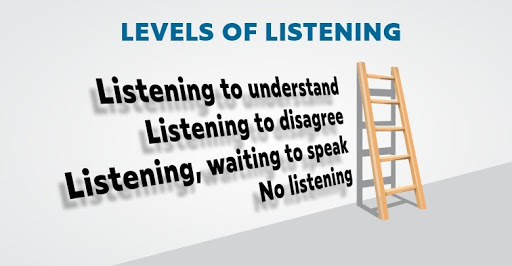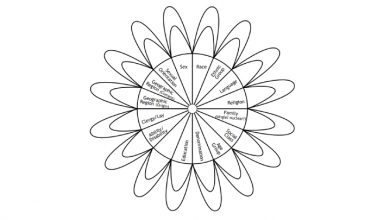Listening as a tool for understanding other realities
Amazingly enough one of the most effective tools for deconstructing and reconstructing reality is to really listen. Because every person’s reality is different and filtered by their own experiences and their own thoughts, the best way to have a perspective of reality that is as accurate as possible is to be in the habit of truly listening to people, especially but not limited to people that you are “at odds with” or consider to be your “enemy”.

Why did I choose this tool?
How does this apply to being a trainer? The way I see it the difference between being a great trainer rather than just being perhaps a great speaker lies in the ability to “listen to understand”. I have been in trainings where the trainer asks participants if they have a question or comment, and a participant responds accordingly, and then the answer or comment that the trainer makes to it had actually nothing to do with what the participant was expressing. This can cause the participant to feel that the trainer is not really “there”, or doesn’t really care about them. This, in turn, can result in the participant disengaging from the training and the learning process. Listening to understand is a skill that is only learned through a lot of practice, and in many cases, it requires more effort and skill as a trainer to listen than to speak. The results are well worth it and will be seen in more successful trainings, more engaged participants and overall much better learning outcomes.
“People don’t care how much you know until they know how much you care”
― Theodore Roosevelt
Main content:
In the following video, former CIA agent Amaryllis Fox explains how her former secret life taught her one main lesson: listen to your enemy. She then goes on to describe how the absence of real listening has created completely different perceptions of reality, which has then resulted in the misunderstandings of each other and the conflicts that we are facing in the world today.
https://www.facebook.com/ajplusenglish/videos/vb.407570359384477/744058605735649/?type=2&theater
Well then if listening is so important and can bring so many solutions, the answer is easy, right? Just listen?
The problem is that what most of us think of as listening is not the kind of listening that has the potential to alter our perspective of reality and create a genuine connection with the other person.
In his book “Understanding Yourself & Others” Bob Thomson states that there are actually 4 different levels of listening.

Not listening – If you’ve ever tried to talk to someone while they were engaged in something else, and perhaps they were saying “uh huh” at random intervals but not really engaging in anything you were saying, then you have experienced firsthand the “not listening” level.
Listening, waiting to speak – This is when you are listening but, in the meantime, you’re reviewing in your head what you are going to say or waiting anxiously for a chance to say your piece. You may politely wait for the person to pause so you can jump in, or you may interrupt them while they are still speaking. In either case, you are “listening waiting to speak”.
Listening to disagree – This kind of listening happens in arguments when someone wants to prove that they are right, or in debates where the whole point is to get your point across so that you can “win” and the other person can “lose”. You are looking for flaws in what the other person is saying, and you are reviewing in your head how you can prove yourself right.
Listening to understand – This kind of listening happens when you are fully present with the other person, don’t allow yourself to be distracted with anything else in your head or in your environment, and you have no other agenda rather than to really understand what the other person is trying to express. Here you consider not only the words that they are saying, but how they are saying it, the gestures they are using and most importantly the emotions that they are portraying.
Although the other types of listening certainly have their time and place, the type of listening that we are referring to in this article, the type that has the potential to transform your reality and to create a genuine connection between two people (even 2 people who might otherwise disagree or even be enemies) is “listening to understand”.
So how do we know whether or not we are listening to understand, and if we realize that we are not generally listening to understand how can we change that?
Listening to understand can include all the following elements, but isn’t possible without at least the first one.
- Empathizing – you need to actually care about what the other person is expressing, and be empathetic towards them. If you don’t feel you are in a state where you can do this, if you feel stressed or angry or anxious, then rather than pretend to care or listen it is better to postpone the conversation for a time when you can fully be present with them and be capable of empathizing with them. When you fake it, and someone is expressing something that is deeply important to them, they can easily pick up on that and in the end, it can have worse results then if you hadn’t had that conversation in the first place.
- Playing back – to show that you’re really listening, and also to double-check if you are actually understanding what they are trying to say, you can summarize what you heard and reflect back their words to them. It’s important if you do this to be open to the fact that you may have misunderstood something and not to let yourself be offended if the person says something like “no that’s not what I meant at all” or “you misunderstood me”. Remind yourself that you are listening to understand, not to be right, and invite them to clarify anything that you may have misunderstood.
- Questioning – this is where you invite the person to express more comprehensively their thoughts and their feelings. Questioning in this context is powerful because in expressing themselves to you they can actually become even more clear about their own thoughts and feelings on the matter. Questioning in this context is so powerful that there are entire healing professions based on asking the right questions (ex: psychotherapy and coaching). Asking the right questions as a trainer can greatly enhance your performance and your connection with the participants. To accomplish this purpose the questions should be open rather than closed, for example instead of asking “did you like the training”, which would bring only a yes or no response, it is more effective to ask “how do you feel about the training”? When you get an answer like “I feel good about it” you can help them to express even more by saying “what aspects of the training do you feel good about, can you give some examples?” It’s important that your demeanor, tone of voice and body language show that you are relaxed, open and interested in what they have to say otherwise you might be asking very open questions while at the same time giving the feeling that you are not open to them at all which can create confusion and cause them to shut down.
Reflection questions:
How often do I practice “listening to understand” vs. the other types of listening (not listening, listening waiting to speak, listening to disagree)?
What aspects of “listening to understand” come easily to me?
What aspects of it are difficult for me?
What can I do to improve my listening skills?
What could change in my life for the better if I become a better listener?
How can becoming a better listener help my career as a trainer?
Exercises:
How to apply it in everyday life:
Whenever you’re having a conversation with someone, whether it’s with someone at the bus stop about the weather, or with your significant other about your relationship, or with someone that has a different perspective than you and really annoys you, check-in with yourself and ask the following questions:
Am I fully present in this moment, in this conversation? Or am I letting external or internal noise take my focus away from it?
What kind of listening am I doing (not listening, listening waiting to speak, listening to disagree or listening to understand)?
If you find that you are truly present and listening to understand, then great keep up the good work!
If you find that you are not really present, then take a deep breath and bring yourself back to the moment and focus completely on the person/people that you are with.
If you find that you are doing one of the other kinds of listening, and you want to switch to listening to understand, then take steps towards it by genuinely empathizing, playing back and questioning.





